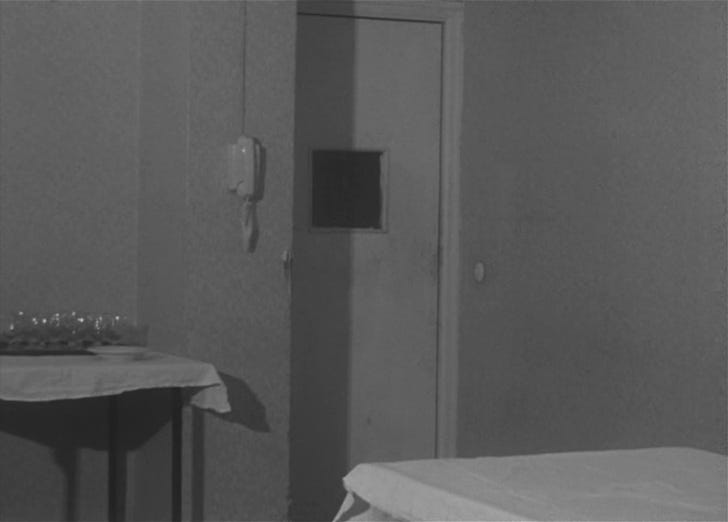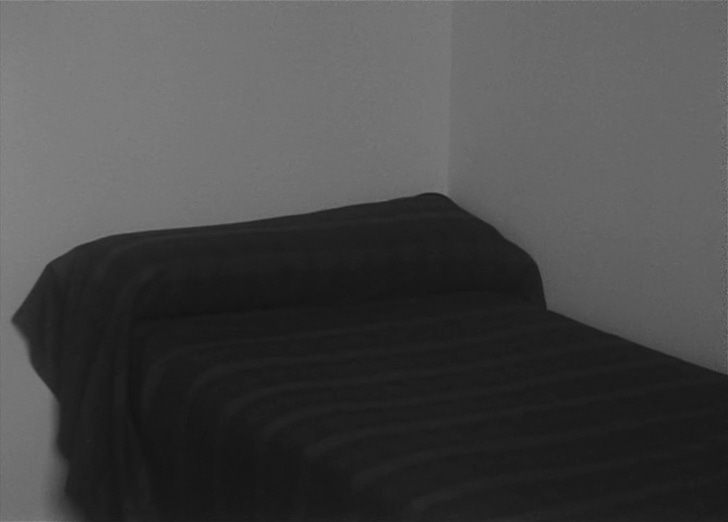The Swinging Door
On the film Contactos (Paulino Viota, 1970)
It’s dangerous to be out on the street. Of course, it’s dangerous to be in the guesthouse, too. It seems like the landlady is always around, listening, watching, noting your coming and going. But it’s more dangerous on the street. It takes two minutes and fifty-five seconds to walk around the block. If you stop and have a conversation with your friend, a car pulls up by the curb and just idles there. It idles there until you move on. Then it drives away. In the meantime, other cars might pass by. They won’t stop. If they notice anything going on, they’ll pretend not to. It’s none of their business. It’s better not to get involved.
There is some sort of plot afoot but it’s hard to say what exactly its specifics are. Details are anything but forthcoming. Even names are divulged only with great reticence. There’s some sort of package wrapped in newspaper. Something goes wrong, there is “havoc.” Two unsmiling men visit the guesthouse. No one in this story is prone to smiling, but there is something different about the way these men are not smiling. The landlady seems afraid of them. They ask about the one of the men staying there. The landlady says he’s not in, although he is – she’s not lying, though; she wouldn’t dare lie to these men. It’s just that he’s not in his room, he’s in the girl’s room. A romance has kindled between them, which the landlady doesn’t know about. All she knows is that they work together. All day, they pass in and out through the same swinging door, carrying trays of drinks in, and trays of empty glasses out. Here, in the guesthouse, the two men come to her door. She only opens it a crack. They ask her about him. She says he’s not there, although he is. He’s pressed up against the wall, hidden behind the door. She asks if she should tell him they were there. They say no, it’s not important, they’re just some old friends. They are not old friends, of course. The man didn’t want her involved in all this. He wouldn’t tell her the details. He still won’t. She is involved in it anyway. Soon, she’s packing her bags. So it goes.
This film, Contactos, was made clandestinely in Spain, during the Franco era. 1970, to be precise. Knowing this, it’s clearer why the film is so claustrophobic, why it is staged almost entirely within a few cramped, spartan interiors. The few exterior sequences take on a double significance – they are moments not only of diagetic risk for the characters within the fictional narrative, involved as they are with their unspecified conspiracies, but moments of actual, real-world risk for the actors and the filmmakers shooting them. Of course, it’s not so incredibly dangerous to spend a few minutes filming a few actors on a sidewalk, even in these circumstances; such an action is not obviously subversive. But this does not mean it was not dangerous at all. Under a fascist regime, you do not want to be open about what you are doing, and who you are doing it with, unless it is exactly what you are expected to be doing. If someone comes to your door, asking about certain names, about contacts, it is much safer for you, and for them, if you can say you don’t know them, if you can say you don’t have any contacts at all, aside from the ones you’re supposed to have. Anything you’re not supposed to be doing, with anyone you’re not supposed to be associating with, it is much safer to do inside, where one can at least know with reasonable confidence how many sets of eyes are watching, how many sets of ears are listening. But of course, even here you’re not safe. In the arms of your lover, perhaps, there’s some brief reprieve to be found, but it won’t last forever. A moment later, the paranoia, the fear will come seeping back into you. And the thing is, this isn’t a bad thing. You need those feelings. They’re what’s keeping you alive.
The workplace of the man and the woman is represented, in the film, only by the swinging door, seen from a single, fixed perspective, from the side where the workers come from, and where they return to, by the workers passing through it, and by, sometimes, the sound of clinking glasses and conversation on the other side (Noël Burch, who, in 1979, called Contactos “one of the most important European films of the past decade,” compares this perspective to that of the early cinema, which often allowed a tableau to unfold before the camera without directing the viewers attention to the events of narrative significance within them). We don’t see what’s beyond this door, except in brief glimpses, and what we see then is too murky and grainy to resolve into anything. We don’t see the room, really, and we certainly don’t see the crowd that we hear, because, of course, the crowd doesn’t exist, couldn’t exist – a film shot in secret could never arrange for that many extras, and even if it could, they wouldn’t look right, they would have the wrong clothes, the wrong bodies, the wrong kinds of living etched in their faces. The ambiance of a crowd can be pulled from any old tape, but the crowd itself can’t be; it’s not part of this world, it’s part of the other one, the one that has organized itself ruthlessly against any film, any person, that would dare to depict the world from the worker’s side of the door.
Contactos was directed by a man named Paulino Viota, who was self-taught as a filmmaker. This was his first feature. This information, like the information that it was produced clandestinely, clarifies much about the film, about the form that it takes, which is not crude so much as direct, elemental, composed according to a grammar of its own invention, optimized for its own purposes. It’s not in any sense a “naive” work – Viota is aware of the conventions of the bourgeois cinema, and he’s aware of the ways those conventions have been challenged in then-recent years; it’s just that here, all of that is more or less beside the point. To simply make this film, under the conditions it was made, is to perform an act of subversion in comparison to which any essentially aesthetic one appears trivial – it is not that the film is not formally daring, it is, it is singular even, but rather, how could it not be? The aforementioned conventions cannot accommodate a work like this; it is not what they were built for, it is not part of their lexicon. The film must break with them out of necessity; there is no other way it can make itself legible. Put simply, it takes the form it does because this is the form it must take, the only form it can take.
There is a particular technique which I think exemplifies this. It’s utilized in certain scenes which either follows some action from the common area of the guesthouse to one of the private rooms, or vice-versa. In either case, these sequences begin and end as locked-down shots of figures imprisoned within the hard-edged geometry of the guesthouse’s barren interior, as cold and precise as anything Duras, or Antonioni, or Robbe-Grillet had done up until then (perhaps not as cold and precise as Bresson, but then, what is?). Between these two images, however, at the point in the scene where the action shifts from one location to the other, there is something different: not a simple cut, nor a pan, nor a smooth, gliding tracking shot, but rather the camera being slightly awkwardly, unmistakably picked up and carried, moving sideways in space, its gaze remaining fixed ahead, then placed back down at the second location. What we have in these sequences is a situation in which the boundary of the proscenium is not transgressed, but in which the bodily presence of the filmmaker is nevertheless made known – made known because it had to be made known, because, with such limited resources, it was the only way in which such a shot could be achieved, and because Contactos is a film which is, in a sense, about nothing else except picking a camera up, and doing what is necessary to achieve what must be achieved.




